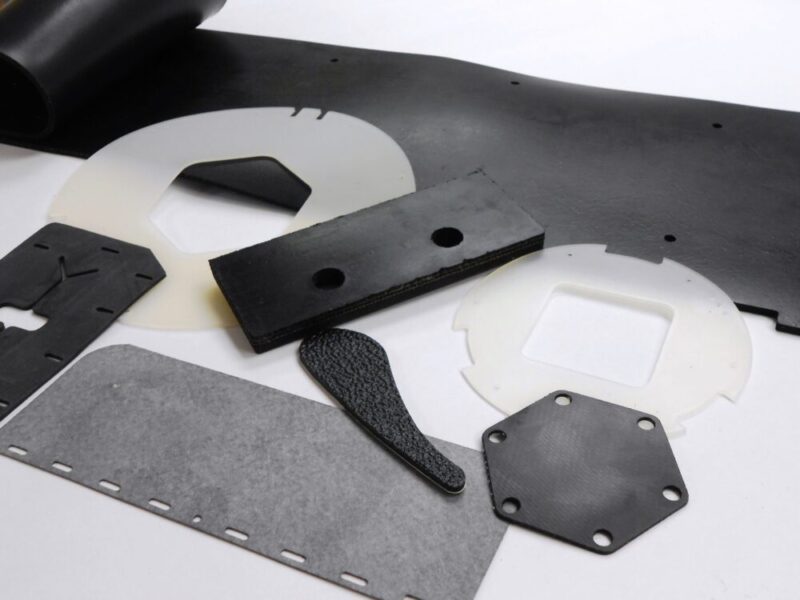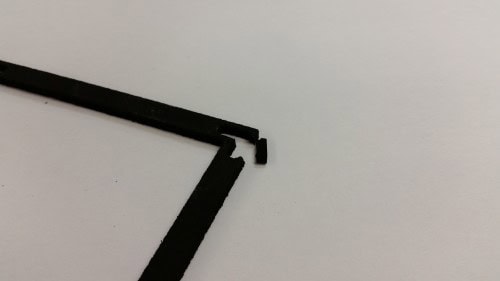Introduction
Since CGR Products’ founding in 1963, we’ve worked with design engineers to bring projects and tools to life — and we do everything we can to make that process efficient, affordable and successful. CGR uses a wide variety of converting methods and equipment to create parts and designs with precision and efficiency.
Throughout these years, we’ve also come across a number of common design mistakes that can be easily avoided. That means savings — in both time and money — for everyone, especially engineers.

We often find that drawings are created with machining level tolerances. This level of accuracy is not obtainable using foams and flexible gasket material. Closed cell neoprene, EPDM, Nitrile, PVC blends, Crushed Foam, Urethane Foam, Cross-linked Polyethylene Foam, and all solid rubber such as Neoprene require more open tolerances than rigid materials like Mylar, Plexiglas, and fiber gasket materials. For die cut foam parts, the Rubber Manufacturers Association (RMA) has developed a design guide for recommended dimensional cut tolerances. These RMA recommendations can be found in the Resource Library on our website at www.cgrproducts.com.
Custom Cutting Processes
Die Cutting: Rotary die cutting and flatbed die cutting are easy, cost-effective and ideal for high volume orders. They provide for easy hole and web removal and are very precise; optimal for producing parts with the tightest tolerances.
Kiss Cutting: This process cuts material without penetrating its backing liner. This is excellent for producing parts in sheets or rolls, like a roll of stamps. The parts can be removed one at a time, with absolute precision.
Knife Cutting: Fast and accurate, knife cutting produces a smooth, clean edge on manufactured parts with a serrated blade. Best for paper, fiber, rubber and foam gaskets, and ideal for running prototype parts due to optimal material yield and no tooling costs.
Slitting: An excellent method for converting adhesive tape into precision rolls of all sizes. The industry-standard method will produce a roll cut to exact engineered dimensions.
Waterjet Cutting: Using a high-pressure water stream, this method is best for soft materials. It can accommodate extremely tight tolerances and produces clean edges in materials up to 9” thick without a cupping effect. Another recommended method for prototype parts with good material yield and no tooling costs.
Despite the high quality and precision of these methods, all materials have certain limitations. Most design engineers work regularly with rigid materials like metals and plastics, and request accordingly tight tolerances. However, flexible materials are not always suited to such tight tolerances — especially when undergoing precision cutting processes.
Many flexible materials are subject to shrinkage rates of up to 5%. This can be a problem for any part, but especially for large parts. We recommend that any design attempt remain as pure and straightforward as possible, while minimizing hazardous elements and potential error. Designs that offer more forgiveness and flexibility — especially in materials that are inherently flexible — have greater chances for success.
The Product Development team at CGR works intimately with this range of materials, and can offer insight from the very beginning of a project’s design. Tighter tolerances raise both costs and risk for mistakes; CGR’s Product Development Team can help answer questions as you consider the softness of material resources in the flexibility of your design.

For a FREE downloadable PDF version to keep for your records:
Download the full version of the 5 Common Design Mistakes Here
It’s easy to be overwhelmed at the wide variety of available materials for your project. Everyone wants a top-of-the-line result, but that doesn’t always mean spending the most money. Our clients often ask for an expensive material that really isn’t necessary — there are plenty of cheaper, highly capable materials that will often serve the same purpose just as well.
For example, three of the polymers from the low-cost range at CGR Products display impressive capabilities.

Neoprene: This general purpose industrial gasket material is resistant to non-aromatic petroleum oils and greases with a standard smooth finish, 500 psi tensile strength, and temperature range of -20 to +170 F.
Nitrile Rubber: Oil, grease and
solvent resistant, this is an ideal material for industrial service. 640 – 700 psi tensile strength, 300% elongation, and temperature range of 0 F to +170 F (exception Nitrile, White, FDA, temperature range -25 F to +180 F).
EPDM: This sheet rubber is a high quality commercial sheet that has excellent resistance to steam, heat aging, ozone, acids and alkalis. EPDM’s electrical insulation properties and water resistance make it a popular choice for cable jointing and other electrical applications. It is also commonly used in automotive vehicle gaskets, appliances, marine, and many other industries.
Another critical area of concern in designing a part is the proper selection of Pressure Sensitive Adhesive materials. Choosing the ideal PSA for the application can be critical to the part’s ultimate performance. The following conditions should be considered when choosing a PSA:
- Bonding surfaces
- Required durability, or long-term performance
- Temperature exposure of part
- UV exposure of part
- Should the PSA be supported or unsupported?
- Is the bond permanent or temporary?
Manufacturers don’t simply supply a range of materials in order to offer flexible rates. Regardless of cost, every material has a unique set of properties and performs differently according to temperature, chemical exposure and so on. When an engineer doesn’t carefully consider a material’s specific performance ranges, the final product often doesn’t live up to expectations in appearance, function and overall results.
In temperature range alone, the CGR portfolio offers materials performing from -150 F to 500 F, and for every range in-between.
Sample Temperature Ranges
- SBR: -65 F to +180 F
- Hypalon: -65 F to +250 F
- Polyacrylate: -20 F to +350 F
- Flourocarbon: -40 F to +500 F
- Silicone: -150 F to +500 F
These are just a few of the materials from the CGR inventory — find the rest in our Resource Library, on our Materials pages, or contact a specialist with your desired performance requests. They’ll be sure to have recommendations for your design needs.

For a FREE downloadable PDF version to keep for your records:
Download the full version of the 5 Common Design Mistakes Here

The Product Development team at CGR Products frequently encounter designs with thin flange widths or difficult hole placement. While cutting processes are precise enough to create these holes, all materials have limitations.
Holes that have been designed too close together, regardless of the precision of manufacturing, will still rip in the final product. This is a disappointment for everyone, and can be easily avoided with early consideration and collaboration between designers and our design team.
The position of bolt holes in a flange are of particular importance, both for the finished piece and the CGR components. All bolt holes should straddle the centerlines of the flange and the centerline should cut through the diameter of the holes. Ideally, bolt holes should not be located near the edge of the flange.
Remember to take extra consideration for the material in your design! Depending upon the liquids to be handled in the final flange project, your gasket may demand different chemical or physical traits.
Our team of specialists (not to mention our deep selection of in-stock choices) can help you select a material that strikes the balance between physical fit for your design’s bolt holes and chemical performance for the final project.
CGR’s Design Team works with complex orders every day, and their insight can inform every step of the process, all the way to delivery. We want you to receive your parts in the easiest, most efficient way. Considering packaging choices from the start of a project is a great way to preempt potential confusion or worse, a mess, at delivery.
As mentioned previously in this guide, kiss cutting is one of our specialties at CGR, and this is a very efficient manner to receive your finished parts. This very particular type of cut produces a sheet or roll of matching parts with a backing sheet, much like stickers or stamps. The parts are crafted on a roll, ready to be removed one by one for application. Giving careful attention to packaging needs, such as whether parts are stacked in a carton or bulk packed, can help avoid problems with part quality and for your operators when removing parts from their carton.
Think about how you’ll need to use your parts, or how you plan to receive or store them. The CGR team offers samples, recommendations and packaging insight for jobs of all sizes.
What can CGR do for you?
Readying a new design for production requires much more than five easy tips. The full CGR Resource Library and team of experts are available to clients with specifications, cost charts, comparative material information on temperature and chemical resistance and more. Our design team works with automotive, marine, appliance, plastic molding, power tool, electrical, small engine and countless other clients. We provide solutions to OEMs, tier suppliers, and military and government contractors.
Our in-house tool and die capabilities mean maximum problem solving with minimal lead times, and an extensive inventory of raw materials supports projects of all kinds. Safety stocks are in place with our inventory of raw materials, and consultation with our experienced staff is always available to get you started.
Ready to get started: Request a Quote today or Contact Us with questions.

For a FREE downloadable PDF version to keep for your records:
Download the full version of the 5 Common Design Mistakes Here



